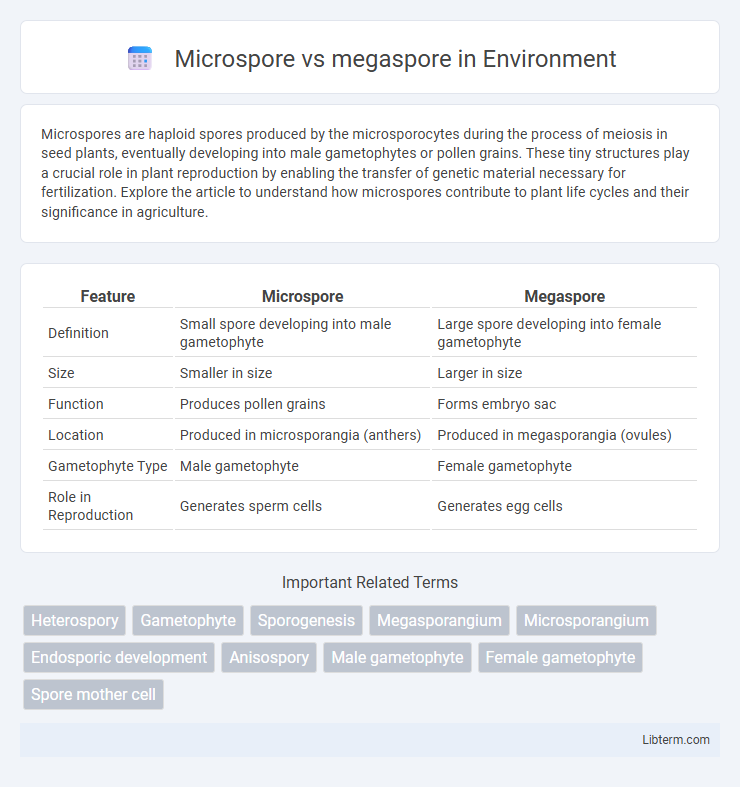Microspores are haploid spores produced by the microsporocytes during the process of meiosis in seed plants, eventually developing into male gametophytes or pollen grains. These tiny structures play a crucial role in plant reproduction by enabling the transfer of genetic material necessary for fertilization. Explore the article to understand how microspores contribute to plant life cycles and their significance in agriculture.
Table of Comparison
| Feature | Microspore | Megaspore |
|---|---|---|
| Definition | Small spore developing into male gametophyte | Large spore developing into female gametophyte |
| Size | Smaller in size | Larger in size |
| Function | Produces pollen grains | Forms embryo sac |
| Location | Produced in microsporangia (anthers) | Produced in megasporangia (ovules) |
| Gametophyte Type | Male gametophyte | Female gametophyte |
| Role in Reproduction | Generates sperm cells | Generates egg cells |
Introduction to Microspore and Megaspore
Microspores are haploid spores that develop into male gametophytes in seed plants, playing a crucial role in the formation of pollen grains. Megaspores are larger haploid spores that give rise to female gametophytes, ultimately developing into ovules. The differentiation between microspores and megaspores is essential for sexual reproduction in heterosporous plants, ensuring the formation of distinct male and female gametophytes.
Definition of Microspore
Microspores are small spores produced by the microsporangia of seed plants that develop into male gametophytes or pollen grains. They play a crucial role in plant reproduction by giving rise to sperm cells necessary for fertilization. Unlike megaspores, microspores are typically much smaller and contribute to the formation of male reproductive structures.
Definition of Megaspore
A megaspore is a type of spore in plants that develops into a female gametophyte, playing a crucial role in sexual reproduction. It is significantly larger than a microspore, which develops into a male gametophyte. Megaspores typically arise from meiosis in the megasporangium and give rise to the embryo sac in angiosperms or the female gametophyte in gymnosperms.
Origin and Formation
Microspores and megaspores originate through meiosis in the sporangia of seed plants, with microspores produced in microsporangia (pollen sacs) and megaspores formed in megasporangia (ovules). Microspore formation involves the reduction division of microsporocytes resulting in four haploid microspores, whereas megaspore formation arises from a single megasporocyte undergoing meiosis to produce typically one functional megaspore. These distinct processes establish the foundation for the male and female gametophytes, crucial for sexual reproduction in gymnosperms and angiosperms.
Structural Differences
Microspores are typically small, unicellular spores that develop into male gametophytes, often characterized by a thinner wall and simpler structure. Megaspores are larger, typically with a thicker wall, and develop into female gametophytes, containing more stored nutrients for embryo development. The size and wall thickness differences reflect their distinct roles in plant reproductive cycles, with microspores optimized for dispersal and megaspores for nurturing the next generation.
Functional Roles in Plant Reproduction
Microspores develop into male gametophytes, producing pollen grains that facilitate fertilization by delivering sperm cells to the ovule. Megaspores give rise to female gametophytes, which contain the egg cells necessary for embryo formation. These distinct functional roles ensure successful sexual reproduction and genetic diversity in seed plants.
Microspore Development Process
Microspore development begins with the microsporocyte undergoing meiosis to form four haploid microspores within the anther's microsporangium. Each microspore then undergoes mitotic division to develop into a pollen grain, which contains the male gametophyte necessary for fertilization. This process is essential for sexual reproduction in seed plants, contrasting with megaspore development that leads to the female gametophyte formation.
Megaspore Development Process
Megaspore development initiates within the ovule through meiosis of the megasporocyte, producing four haploid megaspores, of which typically only one survives. This functional megaspore undergoes mitotic divisions to form the multicellular female gametophyte, also known as the embryo sac, containing the egg cell and supporting structures. Megaspore development is crucial for sexual reproduction in seed plants, enabling fertilization and seed formation.
Key Similarities and Differences
Microspores and megaspores both arise from meiosis within the sporangia of heterosporous plants, playing crucial roles in the plant reproductive cycle. Microspores develop into male gametophytes, typically smaller in size, while megaspores give rise to female gametophytes and tend to be significantly larger. Both spores are haploid and serve as a fundamental link between diploid sporophyte and haploid gametophyte generations, yet they differ in their sizes, developmental fates, and functions within plant reproduction.
Importance in Plant Life Cycle
Microspores and megaspores play crucial roles in the plant life cycle by enabling sexual reproduction through the formation of male and female gametophytes, respectively. Microspores develop into pollen grains, facilitating fertilization by delivering sperm cells to the ovule, while megaspores mature into embryo sacs containing egg cells essential for seed development. This differentiation ensures genetic diversity, successful fertilization, and the continuation of plant species across generations.
Microspore Infographic

 libterm.com
libterm.com